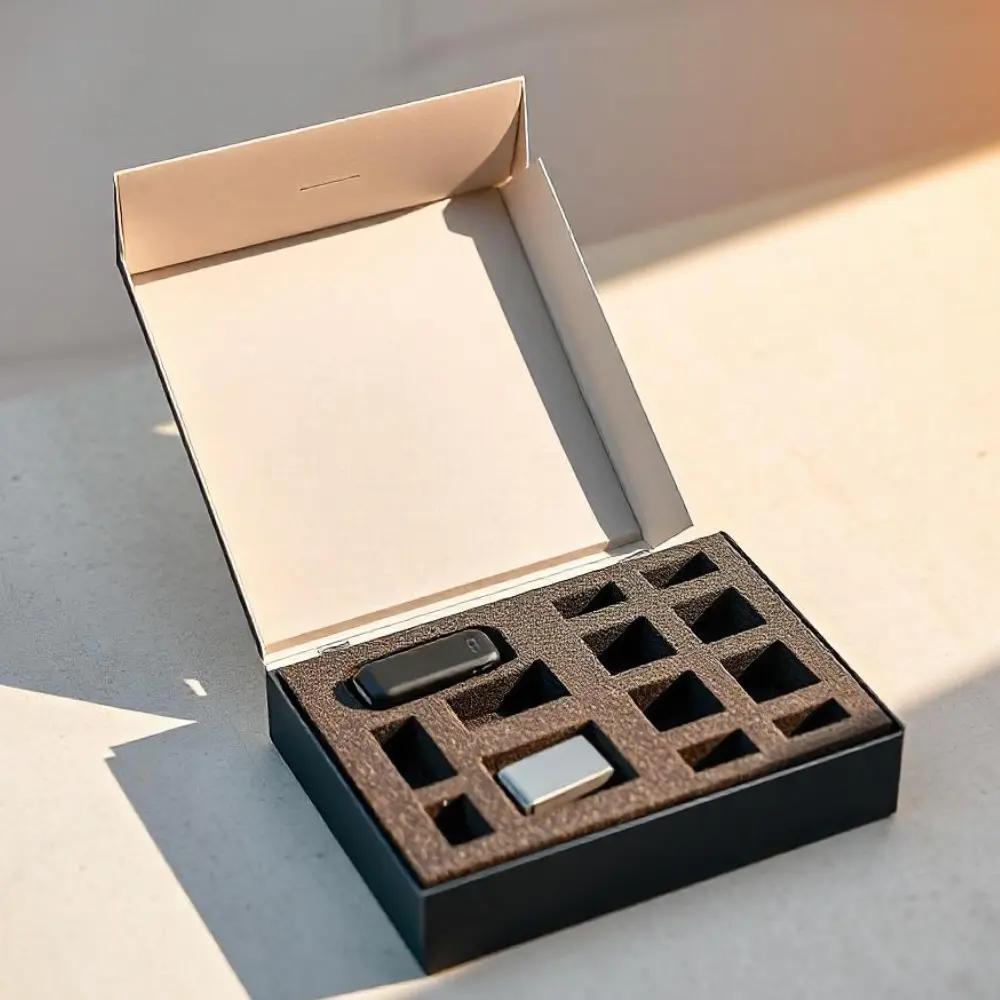What Is Custom Foam Packaging?
Custom foam packaging is a tailored solution designed to protect specific products during storage, transit, or retail presentation. Unlike generic packaging, it is engineered with the shape, size, weight, and fragility of the item in mind.
From die-cut foam inserts to multilayered packaging systems, custom foam solutions offer:
- Shock absorption to minimize impact during handling or transportation
- Precision fit that prevents movement within the package
- Professional presentation that enhances brand perception
- Material-specific advantages based on environmental, chemical, or structural requirements
Industries ranging from aerospace to e-commerce rely on custom foam packaging for its durability, reliability, and adaptability.

Polyethylene Foam (PE Foam)
Overview and Properties
Polyethylene foam, or PE foam, is a closed-cell foam material known for its durability and rigidity. It’s water-resistant, chemical-resistant, and offers superior cushioning for medium-to-heavyweight products.
Key Benefits
- Durable & Rigid: Ideal for repeated use in industrial applications
- Water and Chemical Resistant: Excellent for outdoor and moisture-prone environments
- Superior Shock Absorption: Protects against impacts and vibrations during shipping
- Lightweight: Minimizes shipping weight without compromising protection
Common Applications
- Electronics packaging (e.g., circuit boards, laptops)
- Medical equipment
- Toolkits and industrial components
- Construction materials
Polyurethane Foam (PU Foam)
Overview and Properties
PU foam, or polyurethane foam, is an open-cell material recognized for its softness, flexibility, and fine cushioning. It is ideal for lightweight and delicate items requiring a gentle touch.
Key Benefits
- Highly Flexible: Conforms easily to irregular shapes
- Superior Cushioning: Ideal for fragile or sensitive products
- Lightweight: Helps reduce shipping costs
- Customizable: Easy to shape, cut, and color
Ideal Use Cases
- Consumer electronics (e.g., cameras, lenses)
- Medical devices
- Glassware and ceramics
- Cosmetic packaging
Expanded Polystyrene (EPS) Foam (Styrofoam)
Expanded Polystyrene (EPS), known as Styrofoam, is a rigid, lightweight, and cost-effective closed-cell foam with excellent insulation and cushioning properties. It’s often used for packaging fragile items and temperature-sensitive products. EPS can be molded into specific shapes to provide precise protection.
📦 Key Features of EPS Foam:
- Excellent cushioning and insulation
- Lightweight and rigid
- Cost-effective for many applications
- Moldable into custom shapes
Cross-Linked (PE) Foam
Cross-linked polyethylene (XLPE) foam is a closed-cell foam with enhanced properties compared to standard PE foam. The cross-linking process creates a foam with a smoother surface, increased tear strength, and improved dimensional stability. It offers excellent protection and is often used for higher-value items or applications requiring a more refined aesthetic.
📦 Key Features of XLPE Foam:
- Smoother surface finish
- Increased tear strength and durability
- Improved dimensional stability
- Excellent shock and vibration absorption
- Chemically inert and water-resistant
Ethylene-Vinyl Acetate Foam (EVA Foam)
Overview and Properties
EVA foam blends the softness of PU with the strength of PE. Known for its toughness and rubber-like elasticity, it’s often used in high-performance and high-end packaging.
📦 Key Features
- Tough & Resilient: Handles repeated stress and pressure without permanent deformation
- Waterproof & UV-Resistant: Suitable for outdoor use or exposure to elements
- Smooth Texture: Offers a premium look and feel
- Excellent Impact Resistance: Shields products from severe drops or rough handling
Typical Uses
- Sports and fitness equipment
- Luxury product packaging
- Audio and optical devices
- Protective gear and tools
| Feature | PE Foam | PU Foam | EVA Foam |
| Structure | Closed-cell | Open-cell | Closed-cell |
| Flexibility | Medium | High | Medium-High |
| Moisture Resistance | Excellent | Low (unless treated) | Excellent |
| Impact Resistance | High | Medium | High |
| Best for | Heavy-duty items | Fragile/delicate items | Premium packaging |
| Cost | Budget-friendly | Affordable | Slightly premium |
Ready to discuss your custom foam insert requirements?
How to Choose the Right Foam Material for Your Packaging
Choosing the correct foam material involves evaluating both your product’s physical needs and your business priorities. Here are some key factors to consider:
Product Fragility
Use PU foam for delicate items like glass or medical instruments.Use PE or EVA foam for bulkier or high-impact goods.

Environmental Exposure
Choose PE or EVA foam if your packaging may face moisture, chemicals, or outdoor conditions.
Budget and Volume
PE foam is often the most cost-effective for large volumes.PU foam works well for small to mid-range orders requiring flexibility.
EVA foam is best for high-value items that justify the added cost.

Aesthetic and Branding Needs
PU and EVA foams offer smoother textures and customizable colors, ideal for enhancing brand appeal.Add die-cut logos or product outlines to elevate the unboxing experience.
Why Custom Foam Matters for Branding and Customer Experience
Today’s buyers don’t just want products—they want experiences. Custom foam inserts contribute to a polished and professional presentation, showing customers you’ve gone the extra mile.
Why Custom Foam Matters for Branding and Customer Experience
A snug-fitting foam insert provides a satisfying unboxing moment while preventing shifting or damage. This level of care boosts consumer confidence and reflects positively on your brand.
Tailored Aesthetics
Foam can be:
- Colored to match brand identity
- Embossed or laser-cut with logos
- Shaped precisely for each item, enhancing perceived value
For luxury products or fragile goods, packaging becomes part of the overall customer journey—making custom foam design a marketing tool in itself.
Why Choose Us
Custom foam packaging is an essential element in modern product protection and presentation. By understanding the differences between PE foam, PU foam, and EVA foam, businesses can make informed decisions that balance safety, budget, and brand identity.
At Custom Foam Parts, we offer tailored foam solutions crafted for your exact product specifications. Whether you need simple protective inserts or intricate branded packaging, our experts are here to help you protect your products—and your reputation.
